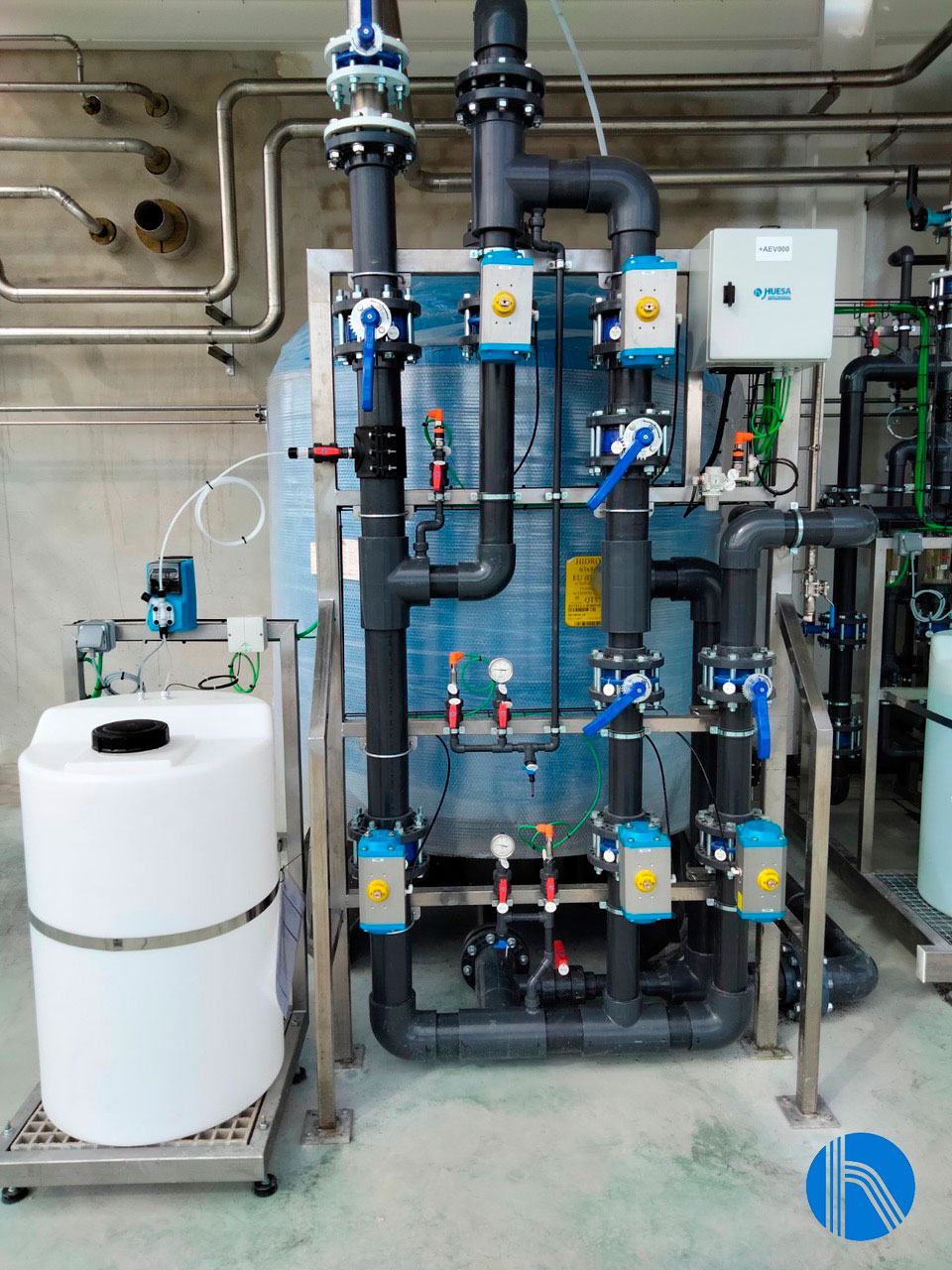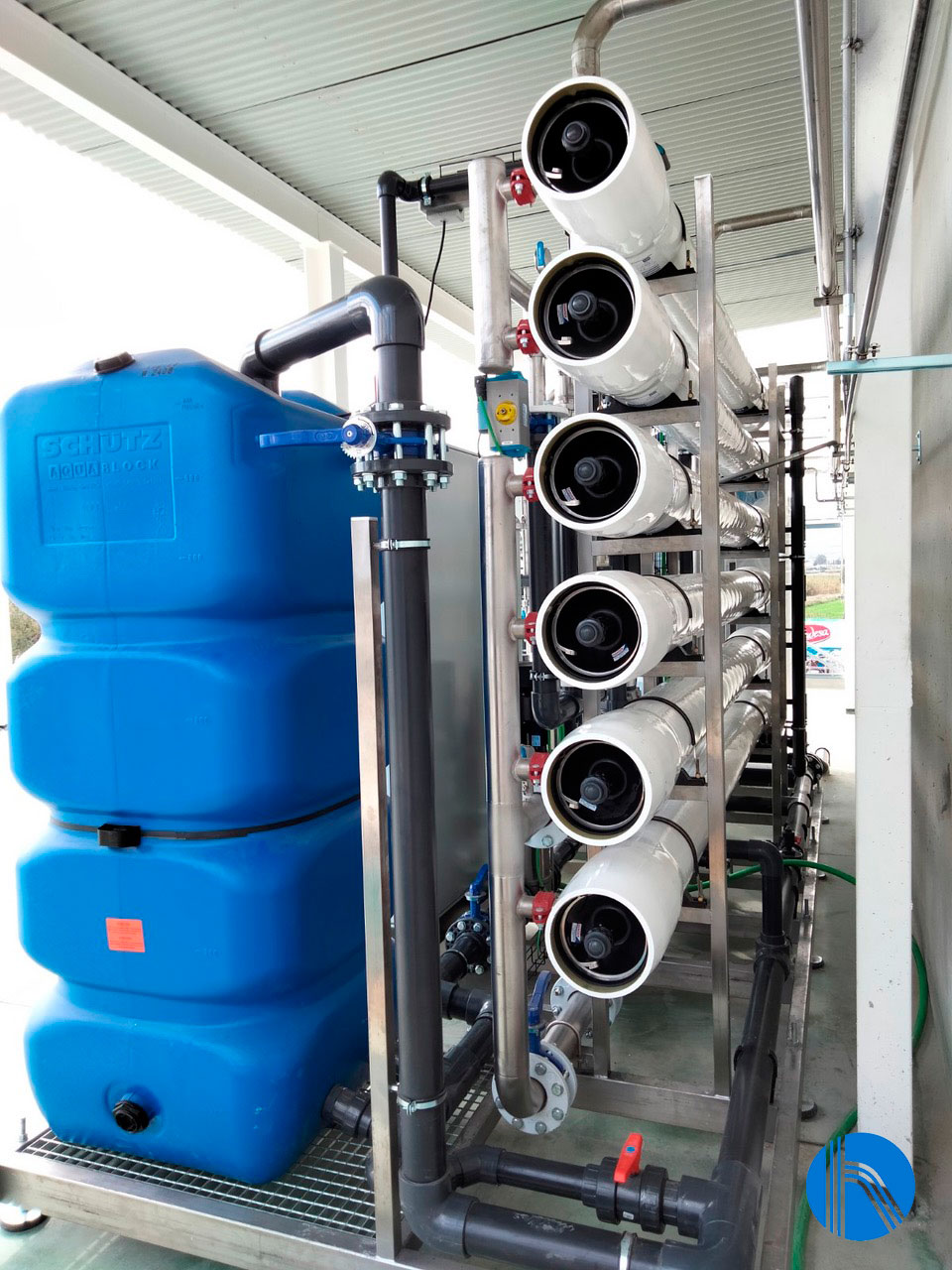A key element in the production system is the efficient use of the raw materials. Water is a raw material that is widely used in the agro-food industry, which is why we are looking at a new J. Huesa successful project in this sector. One of the main national meat company, which exports its products to the five continents, needed to obtain continuous desalinated water to cover the water needs of the steam boilers that supply the scalding room of its slaughterhouse. J. Huesa has designed a customised solution based on the technical objectives of the client and the general objectives of the turnkey project. 
TREATMENT LINE
The installation has been designed considering the following parameters:
| Flow rate to filtration | 29,0 m³/h |
| Osmosis feed flow rate | 29 m³/h |
| Osmosis permeate flow rate | 20,4 m³/h |
| Osmosis rejection flow rate | 8,6 m³/h |
| Conversion | 70% |
| Working hours | 22 h/day |
| Product flow | 20 m³/h |
The treatment plant includes the following sub-processes:
Pretreatment
The water to be treated is chlorinated thanks to the incorporation of a sodium hypochlorite dosing system that has been installed to prevent the contamination inside the filter. Then, water is pumped into a low-speed, automatic backwashing two-layer filter where the suspended solids contain in the raw water are retained.  Specifically, there is a glass fibre reinforced polyester (GRP) filter with a diameter of 1600 mm and a nominal flow rate of 30 m3 /hour. It is equipped with a system of independent valves to carry out the filter cleaning operation. This cleaning process consists of two stages: backwashing and settling. The operation of the valves is automatic and is managed by the automaton located in the control panel included in the osmosis frame. The production of filtered water is interrupted when the filter requests cleaning, which may be due to time in service hours and/or pressure difference detected between the inlet and outlet.
Specifically, there is a glass fibre reinforced polyester (GRP) filter with a diameter of 1600 mm and a nominal flow rate of 30 m3 /hour. It is equipped with a system of independent valves to carry out the filter cleaning operation. This cleaning process consists of two stages: backwashing and settling. The operation of the valves is automatic and is managed by the automaton located in the control panel included in the osmosis frame. The production of filtered water is interrupted when the filter requests cleaning, which may be due to time in service hours and/or pressure difference detected between the inlet and outlet.
Reverse Osmosis
 Pretreated water passes to the reverse osmosis system, where it is filtered throuhh 5-micron pore size cartridges, which will retain possible leaks of particle and suspended solids. To ensure the passage of water through the reverse osmosis membranes, a high-pressure vertical centrifugal pump made of 316 stainless steel has been installed to guarantee the plant’s operating pressure. The reverse osmosis system is a two-stage 4+2 configuration with a conversion rate of around 70% and an input flow of 29 m3 /hour, so that a permeate of 20 m3 /hour is obtained throughout the working day. The membranes are installed in coiled GRP pressure vessels, have a spiral wound configuration, are made of polyamide, and are specially designed for brackish water up to 8000 ppm and have the characteristic of working at low pressure. These membranes have a high chemical resistance, as they can work in a pH range of 2 to 13, which makes them very easy to wash and recover, as they can accept a wide variety of cleaning chemicals. A flushing system has been installed in the reverse osmosis skid to ensure automatic cleaning of the membranes inside the tube. These cleanings are programmed from the touch screen, according to the needs of the operators and/or every time the plant is stopped. In addition, a chemical cleaning or CIP system has been incorporated, which is produced semi-automatically when required by the client, depending on the production requirements. Our client accumulates the osmotised water in a GRP tank in such a way as to always guarantee a continuous supply of osmotised water to the boilers. In addition, the osmosis rejects are stored in another tank, which is used together with a disinfectant to wash the trailers in which the animals are transported and the trucks. The reverse osmosis plant is equipped with instrumentation and control elements (automatic valves, pressure switches, pressure transmitters, flow meters, conductivity, and pH meters, etc.) which are centralised in an electrical panel located in the skid itself. The panel also includes a programmable logic controller and a touch screen for the operation and configuration of the plant. J. Huesa‘s Instrumentation and Control team has designed the control panel so that it can be integrated in the client’s SCADA system.
Pretreated water passes to the reverse osmosis system, where it is filtered throuhh 5-micron pore size cartridges, which will retain possible leaks of particle and suspended solids. To ensure the passage of water through the reverse osmosis membranes, a high-pressure vertical centrifugal pump made of 316 stainless steel has been installed to guarantee the plant’s operating pressure. The reverse osmosis system is a two-stage 4+2 configuration with a conversion rate of around 70% and an input flow of 29 m3 /hour, so that a permeate of 20 m3 /hour is obtained throughout the working day. The membranes are installed in coiled GRP pressure vessels, have a spiral wound configuration, are made of polyamide, and are specially designed for brackish water up to 8000 ppm and have the characteristic of working at low pressure. These membranes have a high chemical resistance, as they can work in a pH range of 2 to 13, which makes them very easy to wash and recover, as they can accept a wide variety of cleaning chemicals. A flushing system has been installed in the reverse osmosis skid to ensure automatic cleaning of the membranes inside the tube. These cleanings are programmed from the touch screen, according to the needs of the operators and/or every time the plant is stopped. In addition, a chemical cleaning or CIP system has been incorporated, which is produced semi-automatically when required by the client, depending on the production requirements. Our client accumulates the osmotised water in a GRP tank in such a way as to always guarantee a continuous supply of osmotised water to the boilers. In addition, the osmosis rejects are stored in another tank, which is used together with a disinfectant to wash the trailers in which the animals are transported and the trucks. The reverse osmosis plant is equipped with instrumentation and control elements (automatic valves, pressure switches, pressure transmitters, flow meters, conductivity, and pH meters, etc.) which are centralised in an electrical panel located in the skid itself. The panel also includes a programmable logic controller and a touch screen for the operation and configuration of the plant. J. Huesa‘s Instrumentation and Control team has designed the control panel so that it can be integrated in the client’s SCADA system.






